Originally published on Alternet.
The problem is simple, surprising, and quite honestly disgusting: Our nation’s older cities depend largely on sewage treatment systems that overflow when it rains, dumping 860 billion gallons of raw sewage a year into “fresh” water across the country—enough to cover the entire state of Pennsylvania an inch deep.
This problem is very, very real for people like Lori Burns in Chicago, whose basement full of sewage and “climate change maggots” recently found its way into the Washington Post. Or for the people of Toledo, where a chronic “combined sewer overflow” problem has combined with runoff from industrial agriculture to drastically alter the ecological balance of Lake Erie, with toxic algal blooms making the city’s drinking water poisonous.
But the stormwater crisis is also a tremendous opportunity to move in the direction of a new, community sustaining local economy.
Traditionally, the solution to keeping sewage out of our rivers and lakes involves capital-intensive expansion of sewage treatment capacity—or even rebuilding these systems altogether to separate out waste from stormwater. Even in the face of strict consent decrees imposed by the EPA, it’s highly improbable that our most cash-strapped cities are likely to be able to find the funds—estimated at over $100 billion nationwide—to sufficiently rebuild their underground infrastructure; in metro Washington DC, this requires 23-foot wide tunnels.
As climate change continues to generate bigger storms and more intense flooding to the point that even insurance companies are beginning to sue cities for inadequate drainage capacity, can we find a way forward?
Happily, new methods of stormwater management are increasingly recognized as compelling alternatives to burying bigger and bigger pipes under our city streets. In green stormwater management, rather than scaling up overtaxed sewage pipes, the point is, wherever possible, to prevent runoff from entering the system in the first place. A rain garden with native plants captures water running off roofs and channels it into the soil, not the streets. Permeable paving does the same for traditionally impervious parking lots.
By reworking the urban environment along ecologically sensitive lines, the green stormwater management toolbox—which also includes urban forestry, green roofs and artificial wetlands—provides an effective way to lighten the load on our sewage systems, while reducing the pollution associated with runoff—not to mention sprucing up our communities with more plants.
But jobs–and new principles of systemic and institutional design that can be implemented in the creation of those jobs—are the real reasons to be encouraged by green stormwater management. Legal pressure from the EPA forcing many local governments to fix their stormwater problem means that, ultimately, stormwater work is being driven by public money, whether directly when that work is done on public lands and streets, or indirectly when the work is incentivized elsewhere to help reduce the total amount of water flowing into the public sewer system.
There’s an opportunity to demand that when public money is spent, it is spent in ways that maximally benefit the public. That means we can also use the stormwater crisis as a real opportunity, connecting public money with “high road” strategies to create much needed jobs—and when possible, develop new forms of democratic ownership.
Green stormwater management has unique advantages: it’s much less capital intensive than the traditional approach, and because it relies on living systems, it helps establish a market for continuous skilled maintenance. Moreover, because it relies on many decentralized small projects, it opens up the space for experimentation with different approaches to create jobs building the needed infrastructure—and at a scale amenable to community ownership and control.
PUSH Buffalo and the Partnership for Public Good’s recent report “Building the Blue Economy” lays out in detail many possible models for such experiments in job and new institution creation, including PUSH Buffalo’s own PUSH Blue initiative—where stormwater projects are being pursued in a targeted geographic area, together with weatherization and other sustainability work. The goal in this “Green Development Zone,” located within—and built with the support of—a low-income community, is to help align multiple economic development projects with long-term organizing for economic equity and sustainability.
Our team at the Democracy Collaborative has also been involved in a project in the Washington, DC metropolitan area that’s taking advantage of the opportunity presented by the stormwater crisis—in this case with an eye to explicit cooperative/community ownership. The first company to launch in the regional Community Wealth Building Initiative will be an employee-owned, green stormwater maintenance and monitoring company located in neighboring Prince George’s County.
The nationwide possibilities are vast, both in terms of the scale of resources that are going to be made available for green development, and in terms of how well suited this particular industry is to providing entry-level jobs for residents of marginalized communities in a tight jobs market.
There are certainly challenges that need to be addressed—the fact that stormwater jobs create low-skilled work for people who need them most now also means that many of these jobs don’t present a clear career ladder. Nevertheless as techniques for green stormwater management are increasingly refined—both Philadelphia and New York City have launched credible large-scale initiatives—and the strategies for capturing the maximum economic benefit for low-income communities are fine-tuned, there are likely to be increasing possibilities for developing further, more advanced jobs as time goes on.
Billions in public money is being spent to deal with stormwater already, with tens, if not hundreds, of billions more all but certain over the next decades. The crisis offers an opportunity not only to create a sustainable infrastructure, but a path to increasing numbers of jobs requiring higher skills rooted locally in new community-building institutions. Not only can such jobs meet an immediate and pressing need in our nation’s urban communities, but the patterns learned and reinforced—solving social problems at the lowest appropriate scale in the interests of both decentralization and efficiency, leveraging the natural world rather than circumventing or ignoring it, and using public money to bootstrap cooperative and community-based enterprises that can multiply the social benefits realized—can provide hands-on training in principles that will serve us well in the larger and ever more pressing green economic transition.
 AMERICA BEYOND CAPITALISM
AMERICA BEYOND CAPITALISM



 Agenda
Agenda  Posterboard
Posterboard 